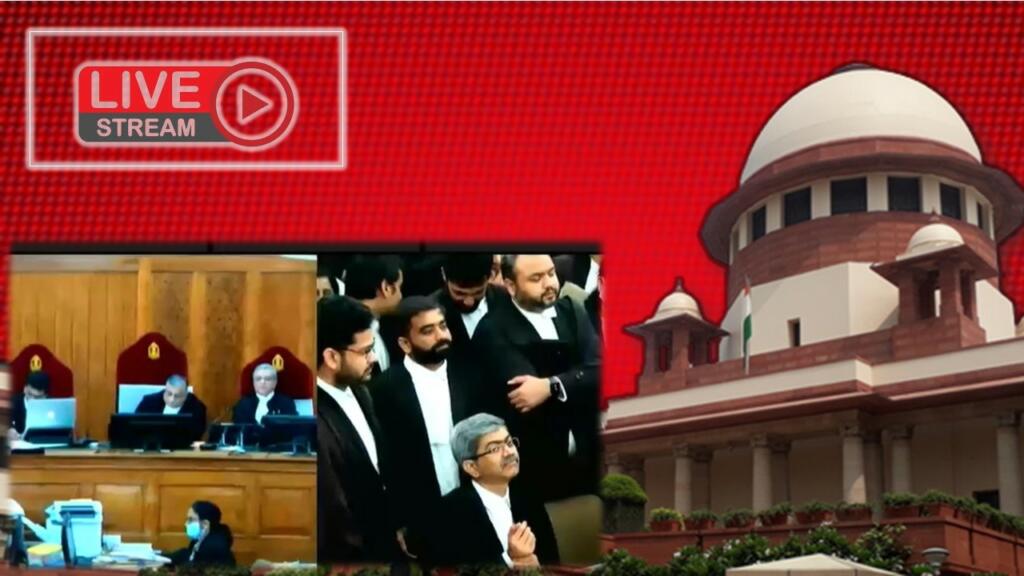Swapnil Tiwari Vs Union of India case: Renowned philosopher Jeremy Bentham once said, “In the darkness of secrecy, sinister interest and evil in every shape have full swing. Where there is no publicity, there is no justice.” Indeed, justice should not only be served, but its process and outcomes should be transparent to all. In the Internet age, this is where live proceedings of court have become crucial.
Open Court and Constitutional Provisions
Open court is the norm, and secret courts should be an exception reserved for cases where public access is detrimental to the interests of justice. Thankfully, in India, it has become the norm. Apart from a few norms and etiquettes in the courts of record, Indian courts have religiously followed it. Additionally, media, both electronic and print, play a key role in abridging people located far away from courts about legal proceedings.
All these forms of transparency and information dissemination are constitutionally sanctioned. Freedom of speech, which includes freedom of the press under Articles 19(1)(a), 19(1)(d), and 19(1)(g), makes it possible for us.
Additionally, Article 145(4) of the Constitution enables the Supreme Court’s pronouncement in open court. Article 129, declaring the SC to be a court of record, adds an extra layer of compulsive transparency to the Apex Court. Similar provisions are enabled by Article 215 of the Constitution for the High Courts. All other subordinate courts have to act in accordance with these constitutional norms.
Adoption of technology by our legal system
However, the advent of the Internet has given birth to another problem. The problem of misquoting and quoting out of context. Even oral observations in the middle of proceedings are reported vehemently. It is the oral observation, called obiter dicta, in the Nupur Sharma case that created uproar all across the country. Truly, the credit for the advent of legal journalism goes to the burgeoning Internet connectivity.
The Indian judiciary had foreseen this problem. They took their own time adapting to technology. It had noted the Internet’s impact in the 1997 Dr. Ashok case. Later, in the 2003 case, video conferencing was given legal sanction for recording the statement of the accused. The presence of a person on a live video screen is a valid way of collecting evidence under Article 273 of the CrPC.
Also read: Anvar P.V. vs P.K.Basheer & Ors : The case that let guidelines for the Evidence Act
Watching the judiciary in action, the executive also decided to pitch in. Way back in 2005, the Manmohan Singh government formed an e-committee regarding it. But the process was slow and tedious. Meanwhile, Internet penetration paved the way for instant justice.
Based on popular perception recorded through Internet numbers, the media started to run its own court. While in cases like that of Nirbhaya, the Internet came to assist the justice system, in the Sarabjeet case, it destroyed the boy’s life as the media declared him guilty before any court would. Ultimately, the guy turned out to be innocent.
Also read: Jallikattu is legally and morally the right of Tamils
Swapnil Tiwari Vs Union of India case and radical openness
The court had an ardent task to balance out all equations in Swapnil Tiwari Vs Union of India. The Apex Court astutely observed the live proceedings all across the world. Jurisdictions like those of Australia, New Zealand, Brazil, the USA, England, Germany, China, the International Criminal Court (ICC), and the International Criminal Tribunal for the former Yugoslavia (ICTY) do provide for live proceedings.
However, not all jurisdictions provide the same level of freedom. For instance, in New Zealand, quoting out of context is illegal, while in America, touted as the greatest democracy on Earth by some intellectuals, only audio recordings are allowed by the Supreme Court in its premises. Similarly, China provides for live proceedings with broad guidelines.
Also read: The love jihad that wasn’t: The Akhila Hadiya case
Taking all these examples, the Apex Court held that the Right to Justice is part of the Right to Life under Article 21. Live proceedings were held as an integral aspect of the Right to Justice. Moreover, Section 327 of the CrPC and Section 153-B of the CPC also provide for an “open court hearing.” To put it simply, live proceedings in court are akin to open court hearings. The only difference is that, unlike in open court, the town hall is real life, and millions of people are present to judge.
The Apex Court is unfazed by it. In the judgement, the three-judge bench of then-CJI Dipak Misra, current CJI D.Y. Chandrachud, and Justice A. Khanwilkar understood the root cause of excessive criticism. The root cause is a certain degree of opacity. They opened their gates for transparency by opining that “sunlight is the best disinfectant.”
It has turned out to be a remarkable landmark in the journey of Indian courts. The radical transparency is nothing but an ode to democracy and signals the judiciary’s intention of listening to proper criticism.
Support TFI:
Support us to strengthen the ‘Right’ ideology of cultural nationalism by purchasing the best quality garments from TFI-STORE.COM
Also Watch:
https://www.youtube.com/watch?v=K0J5MuwvzfM
